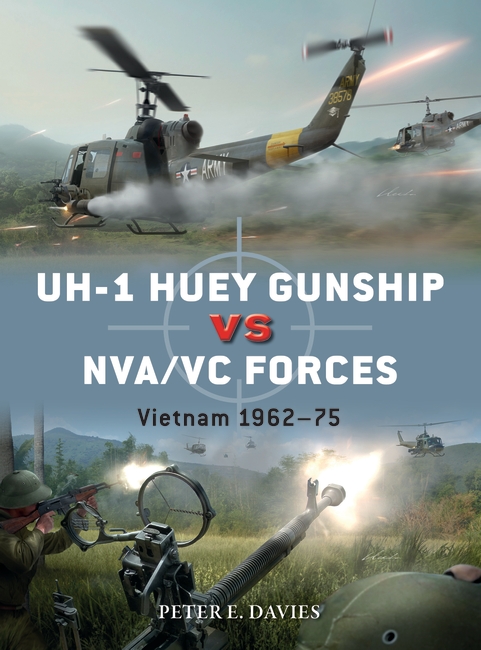On the blog today, author Peter E. Davies gives a brief overview of the UH-1 Iroquois (‘Huey'), the subject of his new Duel title, UH-1 Huey Gunship vs NVA/VC Forces.
The Vietnam War brought unprecedented advances in aerial warfare technology and tactics ranging from air-to-air missile-armed dogfights to the use of laser guided bombs. The most far-reaching development in the land war was the evolution of airmobility. Pioneered in Korea, the use of helicopters to move troops rapidly to flashpoint areas, and extract them equally fast, was revolutionary. The introduction of the turbine-powered Bell UH-1 “Huey” vastly increased the performance and tactical capability of the light helicopter as a rapid reaction, troop-carrying aerial “jeep”. It was simple and reliable, but helicopters were inevitably relatively slow and vulnerable to ground-fire. They needed protection as they approached heavily defended landing zones to insert troops. Tactical jet aircraft could “prepare” the zone with their armament but they were too fast and short-legged to stay with a helicopter assault force and protect it at close quarters. After various experiments with earlier light helicopter types, the US Army evolved the gunship concept.
Previous Ospreys have very effectively described the use of UH-1 “slick” transports but this DUEL title focuses on the gunship variants and their confrontations with enemy defenses. Gunship adaptations of the UH-1B and more powerful UH-1C were in service from as early as 1962. Armed variants of the “slick” transport UH-1s were able to escort the helicopter assault force closely, move ahead to blast enemy defenses with withering volleys of rockets and machine gun fire, and then circle the landing zone to deal with any further enemy opposition. This volume describes and fully illustrates the UH-1 gunships and their mission, explaining the technology and tactics of both sides in detail. Evolving from early experiments with rocket-armed H-13D Sioux light helicopters the range and lethality of gunship armament was steadily increased from 1963 onwards. Assault force escort became one of the most dangerous missions of the war, but the 1,211 US Army UH-1 losses would undoubtedly have been much higher without gunship protection. Armed UH-1s flew over 1.5 million sorties in 1968–70 alone. Many acts of heroism and daring rescues were conducted in very close contact with well-armed enemy forces, enabling US forces to outflank and pursue NVA/Viet Cong troop concentrations.
Later in the war Huey gunships were adapted to carry SS-11 and TOW guided missiles, achieving some notable successes against North Vietnamese T-54 and PT-76 tanks. US Marine units used them for close support and against riverine forces. Their UH-1E carried a powerful twin-gun nose turret. Other gunship variants served with USAF and Royal Australian Air Force units.
By 1966, airmobility became the US Army’s answer for moving troops quickly in difficult jungle or mountainous terrain, but North Vietnamese forces provided strong, well-organized opposition from the outset. The Viet Cong had already gained some experience of shooting at helicopters during the French occupation and at US Army medical evacuation helicopters (despite their Red Cross markings) from 1962. They soon evolved methods of surrounding potential landing sites with heavy machine guns and infantry armed with automatic weapons. The site itself was often booby trapped so that gunships had to detonate these hazards in advance. Co-ordinated heavy AA weapons were often arranged around the area to catch the approaching helicopters or tactical attack aircraft. Both sides developed very effective tactics: the Army for delivery or extraction of troops within a few minutes and the enemy for disguising its defenses and hitting all the elements of the assault force at close quarters. NVA and VC weaponry is described and illustrated in detail and the defenders’ tactics are examined and evaluated in the light of specific combat events and situations.
Early gunship crews worked out combat procedures that would be made easier from 1967 by the introduction of the purpose-built AH-1G Cobra gunship. Using the Huey’s power and transmission systems this faster, more heavily armed aircraft with two crew in a narrow, tandem fuselage, increased the level of protection for assault helicopters. Its success paved the way for Boeing’s formidable AH-64 Apache in 1975.
UH-1B/C gunships continued in wartime service until 1972, including versions that experimented with night visions systems, defoliation gear, and a range of gunpod configurations. The Vietnam War was known as the “helicopter war” for good reasons and the gunship Hueys were vital components in the US war plans throughout it.
UH-1 Huey Gunship vs NVA/VC Forces is out now. Order your copy from the website today!


Comments
You must be logged in to comment on this post. Click here to log in.
Submit your comment